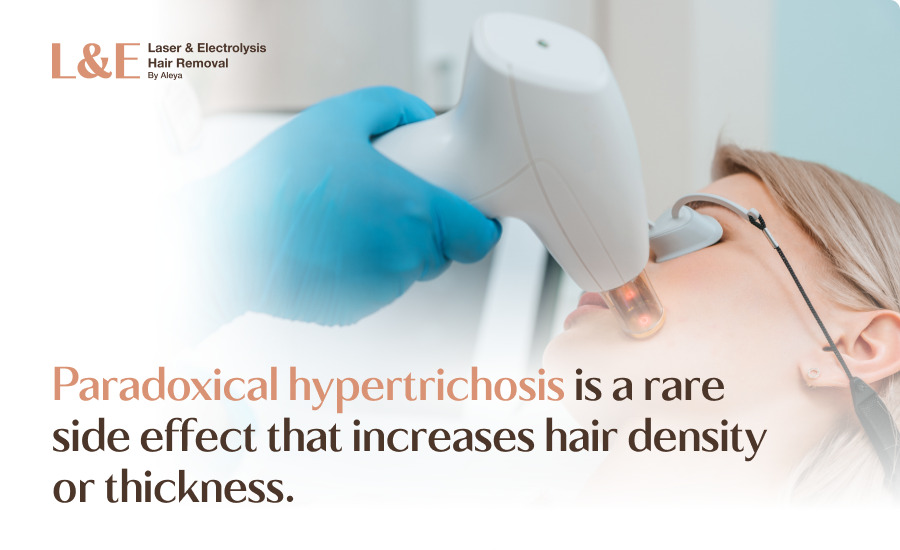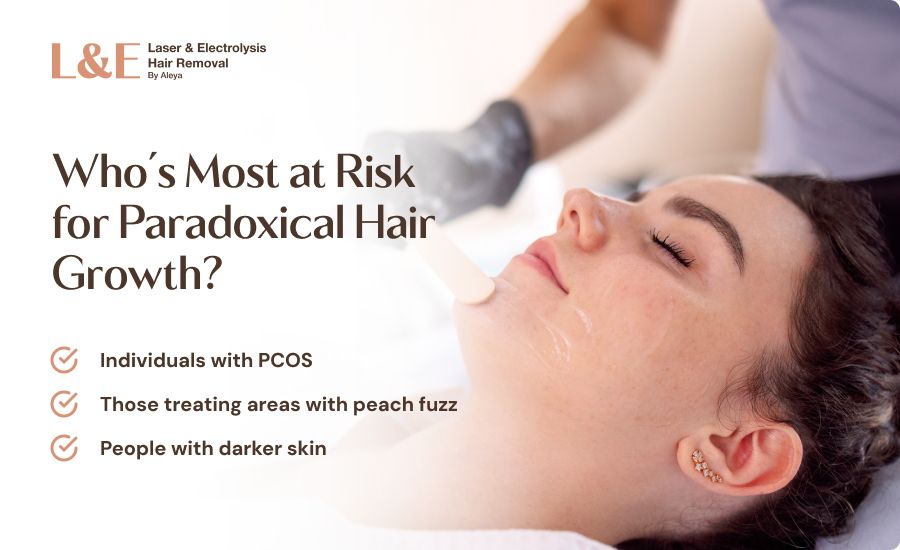Can Laser Hair Removal Cause Unwanted Hair To Grow? [+ FAQs]
![Can Laser Hair Removal Cause Unwanted Hair To Grow? [+ FAQs]](https://www.laserbyaleya.com/wp-content/uploads/2018/02/can-laser-hair-removal-cause-unwanted-hair-growth-hero-image.png)
How Much Does Full Body Laser Hair Removal Cost? Key Takeaways
- When performed by an unlicensed professional, laser hair removal can cause unwanted hair to grow
- Paradoxical hypertrichosis is a rare condition where treatment triggers additional hair growth in or around the treated area
- This paradoxical hair growth is more common when treating areas with fine or fuzzy hair
When laser hair removal isn’t done by a licensed professional or is used on someone who isn’t a qualified candidate, it can lead to some unwanted laser hair removal side effects.
Ironically, one of those is the very thing you’re trying to avoid, which is more hair growth.
In this guide, we will:
- Break down the definition of paradoxical hypertrichosis
- Explore what causes unwanted growth after laser treatment
- Answer who’s more likely to experience laser-triggered hair growth
- Share how to prevent unwanted hair growth after your sessions
Understanding Paradoxical Hypertrichosis
Paradoxical hypertrichosis is a rare side effect in which laser hair removal causes more hair to grow, typically in the same area or immediately surrounding it.
Instead of reducing growth, the laser appears to stimulate new, often thicker or darker hairs, especially in spots with a lot of peach fuzz (like the face or neck).

What Causes Unwanted Hair Growth After Laser Treatment?
In rare cases, laser hair removal can trigger new hair growth instead of stopping it.
This usually happens when the laser stimulates the delicate, light vellus hairs (also known as peach fuzz), causing them to grow darker, thicker, and longer.
So, why does this happen? Experts aren’t entirely sure, but there are two main theories:
1. The Follicle Gets Irritated
Laser heat might target those fine vellus hairs just enough to irritate the follicle without fully damaging it.
As it heals, the follicle can switch gears and start growing thicker, darker hair instead.
2. It Wakes Up “Sleeping” Cells
Some research suggests the laser may activate nearby stem cells that were resting.
These cells can start producing new terminal hairs (the darker, longer kind).
This reaction is called paradoxical hypertrichosis. And while it may sound intimidating, it’s actually quite rare and manageable.
If you’re worried about it, don’t stress.
A skilled laser specialist will take the time to understand your unique skin and hair, discuss what you want to achieve, and craft a safe, customized plan that fits you perfectly.
Who’s More Likely to Experience Laser-Triggered Hair Growth?
Paradoxical hair growth is rare, but certain factors can increase an individual’s likelihood of experiencing it.
You might have a higher chance if:
- You’re treating areas with fine or fuzzy hair
- You have a hormonal condition like polycystic ovary syndrome (PCOS)
- The treatment area is hormone-sensitive, such as the jawline, face, or neck
- You have a darker skin tone and the wrong type of laser is used
- The laser settings are too low to disable the hair follicle properly

How To Prevent Unwanted Growth After Your Session
While rare, those light, fuzzy hairs, especially on the face, can sometimes surprise you by darkening after laser.
If you’re hoping to avoid this altogether, the safest bet is to skip treating areas with a lot of peach fuzz.
To paint a better picture, you can choose to laser your lower legs and leave your thighs alone, since they’re more likely to have those fine vellus hairs.
Need to treat a spot like your upper lip or chin, where both thick and fine hairs show up?
A combo approach might work best. Electrolysis can target and remove finer hairs, while laser treatment addresses thicker, darker ones.
If you’re wondering how laser hair removal compares to electrolysis, we break it all down in our article.
What To Do if Laser Hair Removal Seems To Be Making Hair Removal Worse
Seeing more hair pop up after laser? It’s not your imagination. And no, you’re not stuck with it.
1. Talk To Your Technician
Your provider can reassess your treatment plan. They might recommend adjusting the laser settings, changing the type of laser used, or focusing on specific areas more strategically.
2. Fine-Tune the Energy Level
If the laser’s energy is too low, it may irritate the hair follicle instead of completely disabling it. A slightly higher setting, within safe limits, can often improve results.
3. Consider a Hormonal Evaluation
If you’ve always had thicker or more noticeable hair on areas like your chin, upper lip, stomach, or lower back, it might be a good idea to check in with your doctor.
Sometimes, excess hair in these spots can be linked to hormonal issues like PCOS, thyroid imbalances, or higher-than-normal androgen levels.
4. Switch to Electrolysis for Fine Hair
Laser works best on dark, coarse hairs.
For peach fuzz or hormonally driven hair growth (such as on the chin or jawline), electrolysis may be a more effective solution. It treats each follicle individually and is FDA-approved for permanent hair removal.

Should I Choose Electrolysis Hair Removal Instead?
For many, laser hair removal is a highly effective solution, though it may not be the best fit for every situation, especially when dealing with specific hair types or hormone-related growth.
Consider electrolysis if:
- You’re trying to remove light, blonde, red, gray, or white hairs
- You have fine or fuzzy facial hair, like peach fuzz on the upper lip, chin, or cheeks
- You’re managing hormonal hair growth from conditions like PCOS
- You’ve already had laser, but still see stubborn regrowth in small areas
Experience Trusted Laser Hair Removal at Laser by Aleya
The best way to feel more confident about laser hair removal, especially if you’re concerned about unexpected hair growth, is to book a consultation with an experienced professional, like Aleya.
Think of it as an opportunity to discuss things further.
Aleya will take a close look at your skin, your hair type, and any other factors (such as hormones or sensitive areas) that may impact your results.
From there, she can help you figure out the best approach, whether that’s laser, electrolysis, or a combination of both.
You’ll get:
- A treatment plan that’s tailored to you
- Clear answers about what’s right for your body and goals
- Guidance to lower your risk of side effects and get smoother, longer-lasting results
Can Laser Hair Removal Cause Unwanted Hair to Grow? FAQs
Does hair grow back after laser hair removal?
Hair can grow back after laser hair removal, but it typically returns lighter and finer than before.
Most people experience beautifully smooth skin that lasts well beyond the treatment, often for months or even years.
That said, occasional touch-up sessions may be needed to maintain the appearance of your results, especially in areas with hormonal hair growth.
Is paradoxical hair growth permanent?
No, it’s usually temporary.
If it does happen, your laser specialist can often manage it by tweaking the laser settings, increasing the energy level, or switching you over to electrolysis for that area.
Why does it look like more facial hair is growing after laser?
It might seem like the hair is coming back, but what you’re actually seeing is part of the normal shedding process.
When the laser treats the follicle, it kills the root, but the hair still needs time to work its way out of the skin.
This is called “peppering,” and it can last anywhere from a few days to a couple of weeks.
How can I prevent unwanted hair growth after laser?
Your best defense? A laser specialist who gets how your skin and hair type interact with the laser.
Avoid treating areas with excessive peach fuzz and follow all preparation tips and aftercare instructions.
When should I consider electrolysis over laser treatment?
If you’re up against stubborn peach fuzz or hormone-fueled hair, electrolysis might be the answer you’re looking for.
Unlike laser, it works on most hair colors and skin tones, as it treats each follicle individually.
It’s often the go-to for areas where laser just isn’t effective.
Why is my hair still growing after several treatments?
If you haven’t finished the full recommended number of sessions, some follicles may have been missed or weren’t active during earlier treatments, so they’re still capable of growing hair.
Additionally, your body can develop new hair follicles over time, primarily due to factors such as hormonal changes or aging.
Even if follicles were previously treated, new ones can develop and start growing hair later on.
How does laser hair removal work?
Laser hair removal works by focusing on the color contrast between hair and skin.
Dark hair absorbs more light and heat compared to lighter skin, so when the laser touches the treatment area, the hair absorbs the energy and carries it down to the follicle.
Thanks to the heat, the follicle gets damaged and can no longer grow new hair.
But for this to work well, the hair needs to be darker than the surrounding skin. If your skin is dark or recently tanned, the laser may struggle to focus its energy precisely on the hair.
In this case, both your skin and hair absorb the heat, making the treatment less effective and increasing the risk of irritation.


